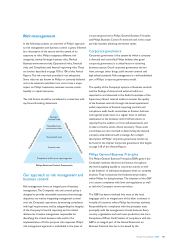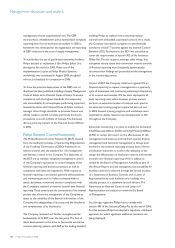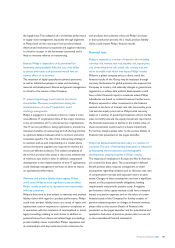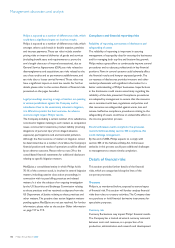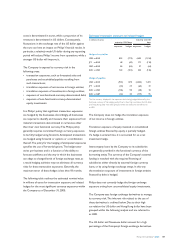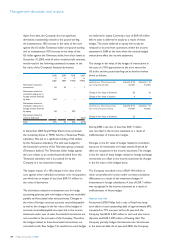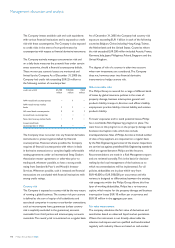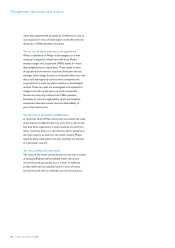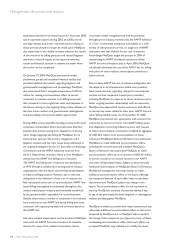Philips 2005 Annual Report Download - page 110
Download and view the complete annual report
Please find page 110 of the 2005 Philips annual report below. You can navigate through the pages in the report by either clicking on the pages listed below, or by using the keyword search tool below to find specific information within the annual report.
Philips Annual Report 2005110
The Company invests available cash and cash equivalents
with various fi nancial institutions and is exposed to credit
risk with these counterparties. The Company is also exposed
to credit risks in the event of non-performance by
counterparties with respect to fi nancial derivative instruments.
The Company actively manages concentration risk and
on a daily basis measures the potential loss under certain
stress scenarios, should a fi nancial counterparty default.
These worst-case scenario losses are monitored and
limited by the Company. As of December 31, 2005 the
Company had credit risk exceeding EUR 25 million to
the following number of counterparties:
credit risk in EUR 25-100
million
100-500
million
>500
million
AAA-rated bank counterparties − 1 −
AAA-rated money market
funds 1 1 −
AA-rated bank counterparties 2 4 1
A-rated bank counterparties − − −
Non-rated money market funds − 1 −
Lower-rated bank
counterparties in China 3 − −
The Company does not enter into any fi nancial derivative
instruments to protect against default by fi nancial
counterparties. However, where possible the Company
requires all fi nancial counterparties with whom it deals
in derivative transactions to complete legally enforceable
netting agreements under an International Swap Dealers
Association master agreement or otherwise prior to
trading and, whenever possible, to have a strong credit
rating from Standard & Poor’s and Moody’s Investor
Services. Wherever possible, cash is invested and fi nancial
transactions are concluded with fi nancial institutions with
strong credit ratings.
Country risk
The Company is exposed to country risk by the very nature
of running a global business. The country risk per country
is defi ned as the sum of equity of all subsidiaries and
associated companies in country cross-border transactions,
such as intercompany loans, guarantees (unless country
risk is explicitly excluded in the guarantee), accounts
receivable from third parties and intercompany accounts
receivable. The country risk is monitored on a regular basis.
As of December 31, 2005 the Company had country risk
exposure exceeding EUR 1 billion in each of the following
countries: Belgium, China (including Hong Kong), Taiwan,
the Netherlands and the United States. Countries where
the risk exceeded EUR 200 million included Austria, France,
Germany, Italy, Japan, Philippines, Poland, Singapore and the
United Kingdom.
The degree of risk of a country is taken into account
when new investments are considered. The Company
does not, however, enter into fi nancial derivative
instruments to hedge country risk.
Other insurable risks
The Philips Group is covered for a range of different kinds
of losses by global insurance policies in the areas of:
property damage, business interruption, general and
products liability, transport, directors and offi cers liability,
employment practice liability, criminal liability, and aviation
products liability.
To lower exposures and to avoid potential losses, Philips
has a worldwide Risk Engineering program in place. The
main focus in this program is on the property damage and
business interruption risks, which also include
interdependencies. Sites of Philips, but also a limited number
of sites of key suppliers, are inspected on a regular basis
by the Risk Engineering personnel of the insurer. Inspections
are carried out against predefi ned Risk Engineering standards
which are agreed between Philips and the Insurers.
Recommendations are made in a Risk Management report
and are reviewed centrally. This is the basis for decision-
making by the local management of the business as to
which recommendations will be implemented. For all
policies, deductibles are in place which vary from
EUR 45,000 to EUR 500,000 per occurrence and this
variance is designed to differentiate between the existing
risk categories within the Philips Group. Above this fi rst
layer of working deductibles, Philips has a re-insurance
captive, which retains for the property damage and business
interruption losses EUR 10 million per occurrence and
EUR 30 million in the aggregate per year.
Fair value measurement
The company calculates the fair value of derivatives and
sensitivities based on observed liquid market quotations.
Where the instrument is not directly observable the
valuation techniques used are qualifi ed and benchmarked
regularly with industry. Values are based on mid-market
Management discussion and analysis



